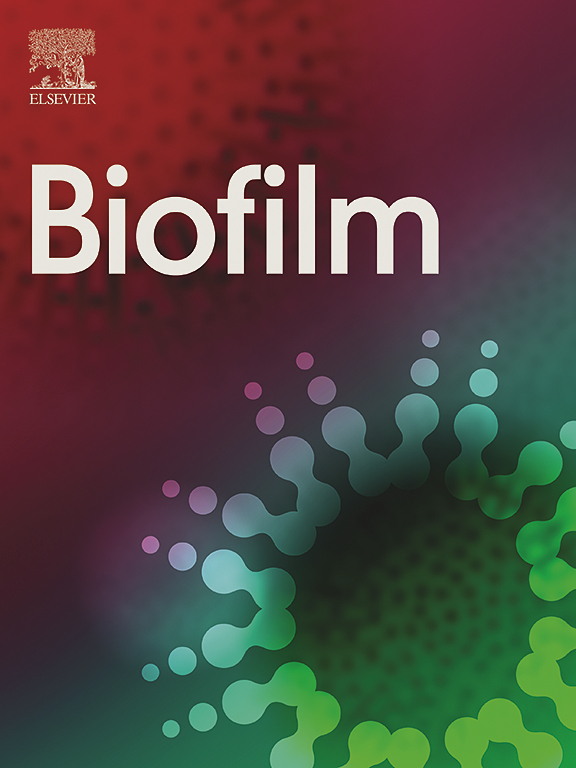Antimicrobial mechanism of in-situ plasma activated water treatment of pathogenic Escherichia coli and Staphylococcus aureus biofilms
IF 4.9
Q1 MICROBIOLOGY
引用次数: 0
Abstract
This study investigated the efficacy and mechanisms of inactivation against Escherichia coli UTI89 and Staphylococcus aureus NCTC8325 through an in-situ plasma-activated water (PAW) treatment. PAW was prepared by discharging atmospheric pressure cold plasma beneath the surface of sterile distilled water. The study investigated the inactivation of biofilm cells and biofilm matrix. In situ PAW treatment of both E. coli and S. aureus biofilms resulted in significant reduction in viable cells of 6.76 ± 0.01 log CFU/mL and 6.82 ± 0.02 log CFU/mL, respectively. Notably, relative to E. coli, S. aureus biofilms were rapidly inactivated by 11 min of treatment. Mechanistically, we demonstrate how PAW treatment led to significant biofilm structure disruption, inducing a significant reduction in biofilm biomass and extracellular polymer substances (EPS) matrix. We propose that disruption of the EPS, facilitated greater interaction between PAW and the bacterial cells of the treated biofilms, resulting in significant intracellular reactive oxygen and nitrogen species accumulation as well as significant membrane permeability with disruption to membrane structure resulting in rapid cell death. Collectively, these findings indicate that PAW effectively inactivates biofilms by targeting the biofilm EPS matrix and biofilm cells in both Gram-negative and Gram-positive bacteria. Whilst PAW is an emerging technology, our study underscores PAW as an effective strategy to control bacterial biofilms of both Gram-negative and Gram-positive bacteria, with utility in diverse sectors and industries. Advantageously, we highlight the multiple mechanisms of action of this technology, which possesses a capacity to overcome the challenges of antimicrobial resistance given that it targets multiple components of bacteria and their biofilms.
原位等离子体活化水处理致病性大肠杆菌和金黄色葡萄球菌生物膜的抑菌机理
本研究通过原位等离子体活化水(PAW)处理对大肠杆菌UTI89和金黄色葡萄球菌NCTC8325的灭活效果及机制进行了研究。通过在无菌蒸馏水表面下放常压冷等离子体来制备PAW。研究了生物膜细胞和生物膜基质的失活情况。大肠杆菌和金黄色葡萄球菌生物膜经原位PAW处理后,活细胞数量分别显著减少6.76±0.01 log CFU/mL和6.82±0.02 log CFU/mL。值得注意的是,相对于大肠杆菌,金黄色葡萄球菌生物膜在处理11分钟后迅速失活。从机制上讲,我们证明了PAW处理如何导致显著的生物膜结构破坏,诱导生物膜生物量和细胞外聚合物(EPS)基质的显著减少。我们认为,EPS的破坏促进了PAW与处理过的生物膜上的细菌细胞之间更大的相互作用,导致细胞内活性氧和活性氮的大量积累,以及显著的膜通透性,破坏膜结构,导致细胞快速死亡。总之,这些发现表明,PAW通过靶向革兰氏阴性和革兰氏阳性细菌的生物膜EPS基质和生物膜细胞,有效地灭活了生物膜。虽然PAW是一项新兴技术,但我们的研究强调了PAW是一种有效的策略,可以控制革兰氏阴性和革兰氏阳性细菌的生物膜,在不同的部门和行业都有应用。有利的是,我们强调了该技术的多种作用机制,该技术具有克服抗菌素耐药性挑战的能力,因为它针对细菌及其生物膜的多种成分。
本文章由计算机程序翻译,如有差异,请以英文原文为准。
求助全文
约1分钟内获得全文
求助全文

 求助内容:
求助内容: 应助结果提醒方式:
应助结果提醒方式:


